SEA VIEW GOVERNMENT SCHOOL (1940
-1947)
CLASS / STANDARD - YEAR - PRINCIPAL - CLASS TEACHER
1 - 1940 - Mr T A Blakeley - Miss PE Turrell married a Mr
Batterson
2 - 1941 - Mr T A Blakeley - Miss EH Jubber - Ms JM Jackson
1 - 1942 - Mr L Llewellyn Gibborn - Ms J N M Anderson
2 - 1943 - Miss Olive Fitzgerald - Ms R Downes - Ms VB Suter
3 - 1944 - Mr Nilsen Palmer - Miss JM Sutherland
4 - 1945 - Mr C Selwyn-Smith - Ms I L Miller
5 - 1946 - Mr C Selwyn-Smith - Ms DB Stocks
6 - 1947 - Mr C Selwyn-Smith - Ms G S Neve
Afrikaans Teacher - Mr Wolmerans
Woodwork Teacher - Mr Lindsay
Note 1: Circa 1918 Mr C Selwyn-Smith taught David
Larsen's mother Ivy Jones at Addington Primary School. The school was
near the Durban South Beach close to Point Road.
Note 2: See bottom of this page for possible names of
pupils.
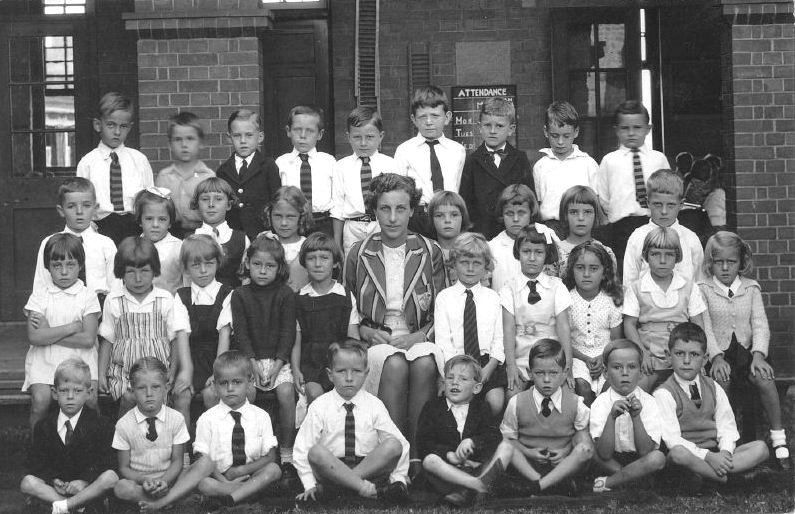
Sea View Government School 1940 - Class 1
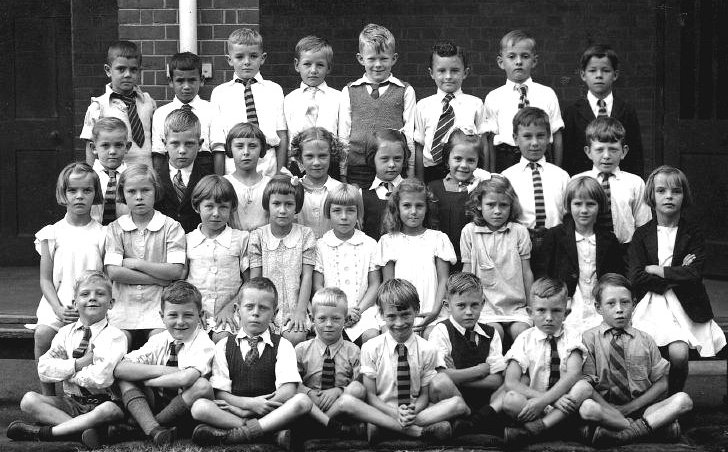
Sea View Government School 1941 - Class 2
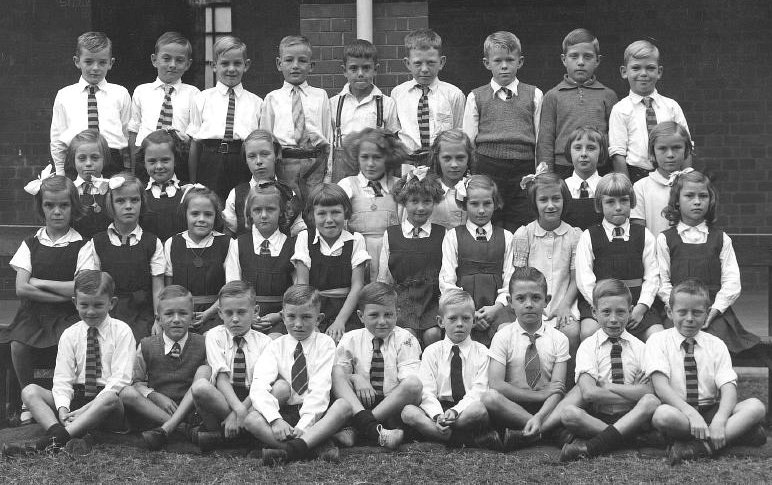
Sea View Government School 1942 - Standard 1
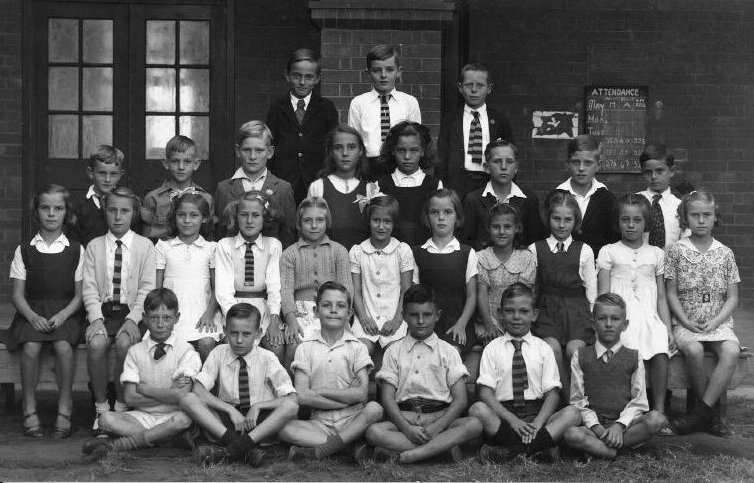
Sea View Government School 1943 - Standard 2
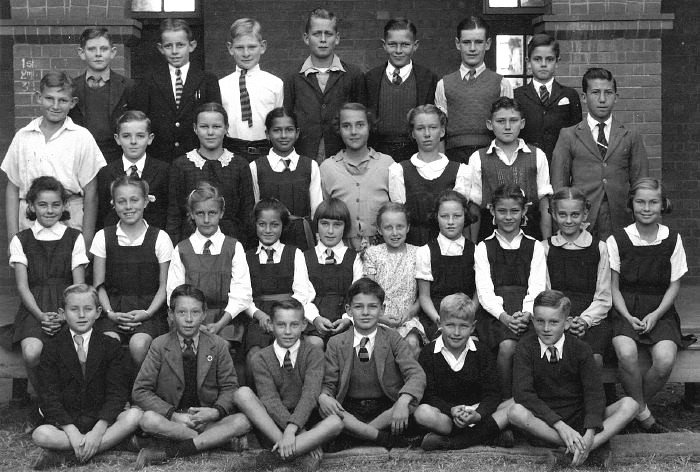
Sea View Government School circa 1945 - Standard 4?
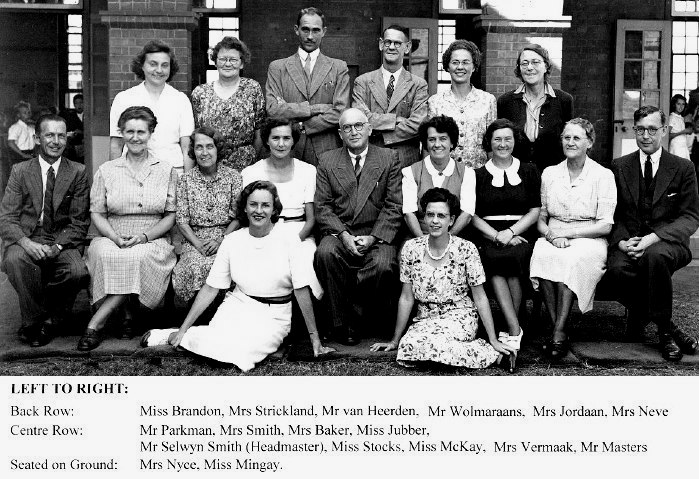
Sea View Government School 1948 - Headmaster and Staff
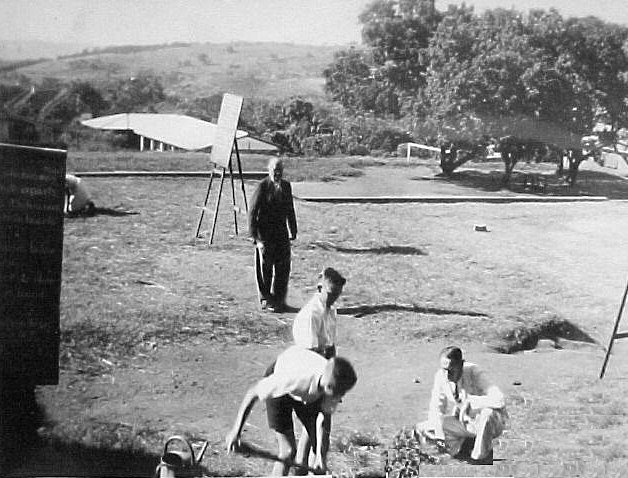
SEA VIEW SCHOOL - ROYAL VISIT (1947)
During the 1947 Royal Visit to South Africa two trees were planted in
the upper playground of the Sea View (Seaview) Government School.
Planting the "Boys Tree" are David Larsen (with spade) and Richard
Askham. Mr Wolmaraans (kneeling) supervises. The school Headmaster Mr C
Selwyn-Smith is standing in the background. (Kneeling behind the left
hand blackboard is one of two pupils planting the "Girls Tree")
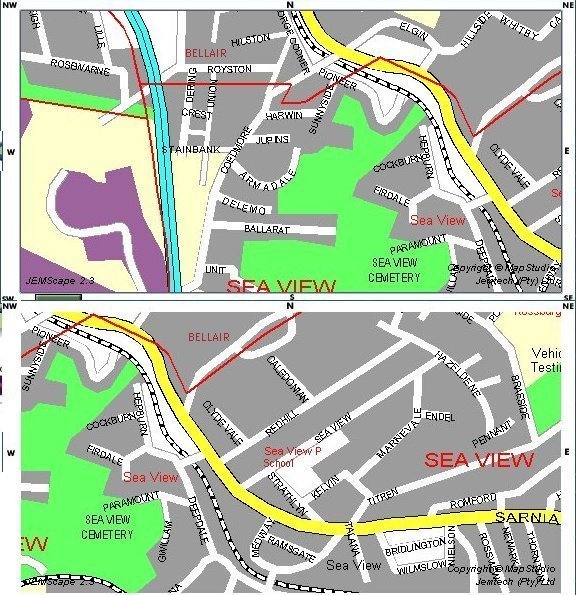
Current Map of Sea View and Bellair
Sea View, Natal: circa 1836
(See British Settlers in Natal: Spencer pages 174-177)
Robert Newton Dunn (1796-1847) arrived in Natal circa 1836 and
purchased the deceased James Collis' farm Sea View in 1838. Where he
built a magnificent house and premises at South Coast Junction (now
Rossburgh). One of Dunn's properties was Saunder's Kraal, renamed
Bellair (5170 acres) After Dunn's death at age 51 his wife continued to
live at Sea View. She laid claim to five 3000 acres farms between the
Umlazi and Umbilo rivers. (see 1842 Map)
John Dunn, son of Robert Newton Dunn, was granted 10 000 acres of land
by Zulu king Cetshwayo after the Anglo-Zulu War of 1879. John Dunn, a
white Scottish trader, had married into a leading Zulu family. John
Dunn died in 1885.
OGLE, FYNN, COLLIS , BIGGAR, DUNN & WOOD
FAMILIES - KEY DATES AND TIMELINE
1785 - Shaka Zulu was born
1795 - Dingaan was born in Babanango
1820 - Circa: Richard and William WOOD and other relatives sailed from
Worcester, England - WOOD family files
1824 - The first white settlers were 26 hunter/traders arrived at Port
Natal. Before the end of the year only six remained - Spencer.
1824 - Henry Francis Fynn and Henry Ogle amoungst those who remain and
lived to see Natal as a British colony -Spencer.
1826 - William WOOD Baptized October 8th 1826
1826 - October. The Zulus deemed all persons who 'wore clothes' to be
Europeans - this included Hottentots (Fynn P129)
1828 - Shaka Zulu. Killed by Dingaan
1828 - Dingaan became paramount chief of the Zulu's
1830 - James Collis started trading in Natal - Cradle Days of Natal' by
Graham MacKeurtan P171
1830 - William WOOD says he arrived in Natal per Circe (Cpt.
Blinkenstock) - his statement has been record by a number of historians
1831 - No mention of WOODs in Travels and Adventures by Nathaniel Isaac
1831 - Jacob (Jocot) Sembite shot dead by Ogle at Canes request with
approval of Dingaan - MacKeurtan P167
1831 - March: COLLIS sells his farm and leaves for Graham's Town with
party of 10 Europeans & 3 wagons- Shelagh Spencer Vol. 4 P149
1831 - August: James COLLIS and party of Englishmen were in convoy on
the way to Port Natal - Diary of Henry Francis Fynn P207-P209
1831 - Richard WOOD arrived in Natal with James Collis - History of
South Africa by G. McCall Theal (ref Mike O'connor)
1832 - James Collis given Port Natal by Dingaan - Shelagh Spencer Vol.
4 P150
1832 - James Collis returns on a further trading expedition -
MacKeurtan P167
1832 - Three Cawooods, Samuel, James and Joshua - all 1820 settlers in
Natal to trade ivory, left in 1833 - MacKeurtan P167
1832 - CJ Pickman arrives in Natal
1834 - April. James Collis and Richard WOOD left (from Graham's Town)
for Natal. "Rule of Fear" P153
1834 - Circe's first voyage (after registration) to Natal took place in
1834
1834 - Richard WOOD, (late arrival - in employ of James Collis),
remains in Natal - Dairy of Henry Francis Fynn - P236
1834 - Richard WOOD already in Natal - mentioned in a number of books
1835 - At close of 1834 J Bertram visits Dingaan and reports that 16
Boer wagons with 40 shots arrived at PNÊP169
1835 - January. Allen Francis Gardener - arrives in Port Natal -Warmly
received by James Collis - MacKeurtan P171/172
1835 - March. The Circe left Port Elizabeth on her third voyage which
was to Port Natal - Records of Natal Vol. 3
1835 - After leaving Natal the Circe was never seen or heard of again -
Records of Natal Vol. 3
1835 - FYNNs leave Port Natal - They returned some time later-
MacKeurtan P169
1835 - Dr Andrew Smith and Mr Edie Journey through Natal and send
favourable report to Cape - MacKeurtan P169
1835 - About 30 male residents in Port Natal - Cradle Days of Natal' by
Graham MacKeurtan P171
1835 - Other 1820 settlers in Port Natal in 1835 - see list below
1835 - Dingaan orders that no White Man can trade except under
Gardener's permit - MacKeurtan P171
1835 - Allen Francis Gardener presides over meeting that establishes
town of D'Urban - MacKeurtan P171
1835 - Richard WOOD, signs support of missionary establishment at Natal
request, to Captain Gardiner. Annals of Natal, Vol. I
1835 - September. James Collis killed in an explosion - MacKeurtan P184
1835 - William WOOD: before he was 12 was a full partner of Robert
Russell in a hunting expedition (1835-11=1825)
1836 - American Missionaries arrive Port Natal - Cradle Days of Natal'
by Graham MacKeurtan P171
1836 - American Missionaries describe home of the WOODs and say only 2
white woman living in Natal - MacKeurtan P302/330
1836 - Gardener makes unfavourable allegations to the 'Select
Committee' about the Settler in Port Natal - MacKeurtan P188/189
1836 - First Fruits Saga: JEKE, JEMISE AND KAJU - see Mike O'Connor's
notes
1836 - William WOOD: Attends American mission school - Cradle Days of
Natal' by Graham MacKeurtan P171
1836 - William Wood: was the only white child of 12 that was enrolled
enrolled at Champion's school - "Rule of Fear" P189
1836 - May. Alexander Harvey Biggar moved to Natal with his younger son
George
1836 - Robert Newton Dunn and his wife Ann moved to Natal. Ann Dunn was
the daughter of Alexander Harvey Biggar Biggar
1836 - June. William WOOD: went on a trading mission (the Jeke and
Jemuse story) - "Rule of Fear" P191
1836 - William WOOD: at age 12 was member of expedition against the
Swazi Chief Soposa (1836-12=1824)
1837 - Wesleyan missionary Edwards and his wife horrified by reports of
cannibalism - MacKeurtan P122
1837 - Port Natal Volunteers under Commandant AH Biggar formed and
disbanded - MacKeurtan P198
1837 - In May Captain Allen Gardener returns and his claim to authority
is 'rejected' by the Settlers - MacKeurtan P198
1837 - William WOOD: mistaken for a boy of about 16 years of age
1838 - William WOOD: before he was 14 saw Retief killed by Dingaan
(1838-13=1825
1838 - February 6. Retief Killed by Dingaan. Revd Owen and (young)
William WOOD witness the slaying
1838 - Richard WOOD and brother William WOOD are killed at the Battle
of Tugela.
1838 - Richard and William WOOD killed by Natives, young William
escaped and swam to safety - WOODY's family files
1838 - William WOOD and his mother 'walk' to Graham's town - 4 month
Journey - Collard Papers
1838 - Robert Newton Dunn (1796-1847) arrived in Natal circa 1836 and
purchased the deceased James Collis' farm Sea View in 1838.
1840 - Statements Respecting Dingaan by William WOOD - published by
Collard & Company, Heerengracht 1840
1842 - Map of Port Natal dated 1842. Shows camps of Wood's, Mr Dunn's,
American Church Mission, Berea, Boere Camp etc.
1843 - Circa: William WOOD circa 17 yrs old, transporting supplies into
the interior of Africa (1826+17=1843)WOOD files
1843 - The British were at war with the Natives when William WOOD was
transporting supplies in Africa - WOOD files
1846 - Young William WOOD lived in the wilds of Africa until he was
about 20 (1826+20=1846) - WOOD family files
1849 - January. William WOOD married in January at age 22
(1849-23=1826)
1854 - The first school Richard WOOD (son of WIlliam WOOD) attended was
in Clonmel, Tipperary Co. Ireland
1856 - Circa. Richard WOOD next attended school in Boothe, a suburb of
Liverpool . William WOOD kept a hotel in Liverpool.
1858 - Liverpool to Antwerp, Belgium from Antwerp on 1 September -
arrived in New York on the 23rd of October.Ship Mary Glover.
1860 - William WOOD and son Richard, Both in U.S.Civil War, Savage
Station. Picture
1868 - Richard WOOD started west to become a telegraph operator at
Elko, Nevada
1874 - Feb. 15, Richard WOOD marries Martha Crowley
1904 - Sea View Government School established
1923 - Issue of crown grant to JC Chesterton & J Anderson as
trustees of Sea View Assembly Hall. Lot l of 126 of block E of farm
"Seaview"
1985 - October. Mr Fynn had 1 European wife and 6 African wives. He is
the father of some 40 Natal families - Sunday Times
Durban, Natal: 1858
(Excerpt from Reminiscences of Old times in P. M. Burg by William James
(in the Natal Archives) as printed in More Annals of Natal by A.F.
Hattersley.)
"On the 25th March 1858, I arrived in Natal by the sailing ship
Quathlamba of 400 tons burthen, in command of Captain Harrison, leaving
London docks on the 12th December 1857.
Vessels arriving in those days had to anchor in the outer anchorage, as
there was never more than four or five feet of water on the Bar.
Passengers were towed into port in a lighter, and carried to shore on
the back of a native, as no landing stages or wharves then existed.
This operation had its amusing side, especially to the lady passengers.
The Point at this time looked anything but inviting to newcomers, with
only one permanent building, the Custom House; and some ramshackle
wooden buildings in the occupation of a couple of landing agents. Huge
sandhills abounded almost to the water's edge. As no hardening had yet
been done, the ground was a deep loose sand. A narrow causeway, about
12 feet wide, had been cut through the natural bush to enable loaded
ox-waggons and carts to reach Durban. Not more than two or three
sailing vessels arrived at the Port per month.
In order to give a true picture of what Durban was like in 1858, I can
best describe it just as a sandy flat. The Town gardens were an open
piece of waste ground, the wind having full play on the fine sand,
creating sand drifts. An open drain extended extended from vacant land,
then called "the Flat", across central West Street and emptying itself
into the Bay. This was Milne's drain. The "back beach," as it was then
called, was almost blocked by a high mound of sand, which was added to
on every occasion of a strong wind. The beach facing the outer
anchorage was seldom, if ever, free from wrecks.
Grey Street was the boundary of Durban, and beyond was a fairly dense
bush. The large trees harboured a number of small monkeys. The whole of
the Berea was covered with thick bush in which grew very large
indigenous trees which were the source of supplies of firewood to the
residents of Durban."
History of Durban by Peter Johnston
Durban lies in the Province of KwaZulu-Natal which is the ancestral
home of the Nguni people. Probably the first European to have sight of
the bay around which Durban was to develop was Vasco De Gama on his
pioneering sea voyage to India in 1497. There were other brief visits
to Durban, mainly by shipwrecked sailors, but nothing of real
importance happened for centuries. The European settlement of South
Africa began in Cape Town in 1652 with the arrival of Jan Van Riebeeck
to provide a half way halt for ships of the Dutch East Indian Company.
It subsequently fell under British rule and it was from Cape Town in
1823 that Captain Owen of the Royal Navy sailed, being charged with a
survey of the southeast coastline. A favourable report was made of the
Bay as being the best site to establish a port to trade with the local
Nguni. A trading company was floated in Cape Town which received the
blessing of the Governor of the Cape, and in 1824 about 30 Europeans
settled in Durban with the purpose of trading in skins and ivory.
At this time all the Nguni tribes had been united under Shaka who was
the King of the Zulus. Shaka had great powers of leadership, was a
brilliant military tactician but was ruthless to his enemy. When the
White traders arrived there were very few black tribes between the
Tugela River to the north and the Umzimvubu River to the south. In the
Durban area there were about 200 refugees from the Luthuli clan who
lived on the headland to the south of the Bay referred to as the Bluff.
The party of Europeans made immediate contact with Shaka who granted
them a section of land of about 35 kilometres along the coast and 160
kilometres inland. The small settlement barely survived and by the end
of 1824 only six were left. This number gradually increased over the
years until in 1835 seventeen men gathered at the home of F. Berkel for
a meeting under the chairmanship of Captain Alan Gardiner who had
established a mission which he named Berea. At this meeting it was
decided to name the small settlement DOUrban after Sir Benjamin DOUrban
who was Governor of the Cape Colony at that time.
In 1838 Dingane, who had succeeded Shaka in 1828 gave all the territory
between the Tugela River and the Umzimkulu River to Boers who were
people mainly of Dutch descent who had trekked overland from the Cape
to escape British rule and were looking for land to farm. They
established their capital in Pietermaritzburg, about 90 kilometres
inland from Durban. The Boer Republic of Natalia was founded and Durban
was considered part of it.
Tension between Boer and Brit reached a head when Captain Smith was
sent to Durban with a small force of soldiers with instructions to keep
the peace between the Zulus and the Boers. This was resisted by the
Boers and the small British force was defeated by them at the Battle of
Congella and besieged in their camp. There followed an epic ride by
Dick King who undertook the journey on horseback to Grahamstown, in the
Cape Colony nearly one thousand kilometres to the south to call for
reinforcements. In little over a month the siege was lifted, by 1844
the Boer Republic of Natalia was annexed to the Cape and named the
Colony of Natal. Most of the Boers left to settle further into the
interior of South Africa.
From 1849 to 1851 over 4 000 British settlers came to Natal under a
scheme which was devised by Joseph Byrne. There were many businessmen
amongst them and from this time onwards the small village of Durban
began to progress. Shortly after this event it was found that sugar was
a suitable and profitable crop to grow and the development was rapid.
It was this development which prompted the Province to import labourers
from India and these in turn were followed by traders. Today their
descendents form a very important part of the Durban citizenry. In 1854
the settlement was granted borough status and the first Mayor and
Council were elected. By the end of the century Durban had electric
lighting, water borne sewerage, water reticulation and hardened roads.
The harbour which had caused problems because of the low clearance on
entry was finally dredged to sufficient depth to allow large ships
entry and from this time onwards Durban progressed to become AfricaOs
largest port.
Although Durban was originally founded as a port to trade with the
people of KwaZulu-Natal it was fortuitous that gold was discovered in
Gauteng (previously known as the Transvaal) in 1886 and it served as a
port for the ever increasing population of the hinterland. The first
railway line in South Africa was laid out in Durban in 1860 linking the
port with the town. During the remainder of the century the railway
system was extended and by 1895 the line had reached Johannesburg which
was the centre of the gold mining industry. There were also lines to
the Free State and to the north and south of Durban. Not only were
these lines important for the movement of goods but they also served
many passengers and Durban became important as a holiday resort, a
position it has retained ever since.
Towards the end of the 19th century and the beginning of the 20th
century many industries came to Durban. There were industries that were
port related such as marine engineering works and stevedoring
companies. It was found at that time that Durban was advantageously
situated for the manufacture of paint. The long sea haul from England
was economical for the importation of many paint components and the
shortest route to the major market at Johannesburg was another
advantage.
The discovery of coal in the Dundee area of KwaZulu-Natal was a boost
to the railway service and enabled Durban to become a major port for
the bunkering of ships. The construction of the Maydon Wharf in 1905
increased the capacity of the port still further and the dry dock which
was installed shortly thereafter added a further dimension to the port.
Today Durban is a very well equipped harbour and the main container
port for South Africa.
The population of Durban has always been augmented by the arrival of
military personnel during times of war who elect to stay on thereafter.
This happened after the Zulu War of 1879, the War of Independence in
1881, the Boer War of 1899-1902 and the two World Wars. Some of these
soldiers turned out to be prominent citizens in subsequent years.
Mainly with the advent of the railways, a number of villages sprang up
around Durban. Some of them on higher ground or in attractive coastal
areas became fashionable residential suburbs and by 1932 the density of
the population around DurbanOs boundaries made it logical to
incorporate these areas. With this incorporation the surface area of
Durban increased almost sixfold and in 1935, one hundred years after
the name of Durban was decided on, the town was granted City status.
During the 20th century, the City has witnessed a large increase in
industry and a corresponding addition in the unskilled and semi-skilled
labour force. From about 1930 onwards this led to an unplanned
development of shacks and other dwellings in open spaces around the
periphery of Durban. From about 1960 onwards the city responded with a
vigorous housing programme which has resettled many of these workers in
formal homes in townships around Durban. The apartheid policy of
resettlement and the impact it had on city form cannot be ignored. An
electric train service is provied to the townships.
From 1996 Durban has once again been enlarged to form a Durban
Metropolitan Area which contains over 2.3 million people and which is
divided into a series of sub-structures that have independent status.
Names of Pupils
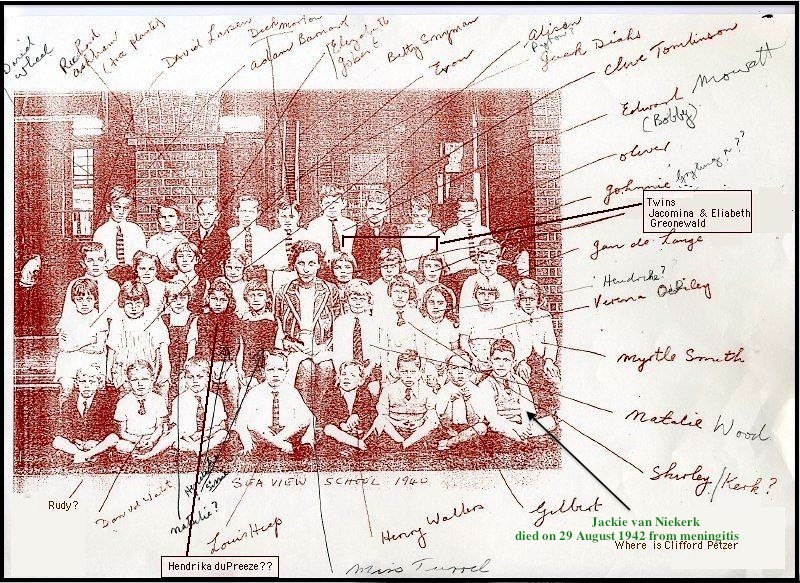 Names?
Names?
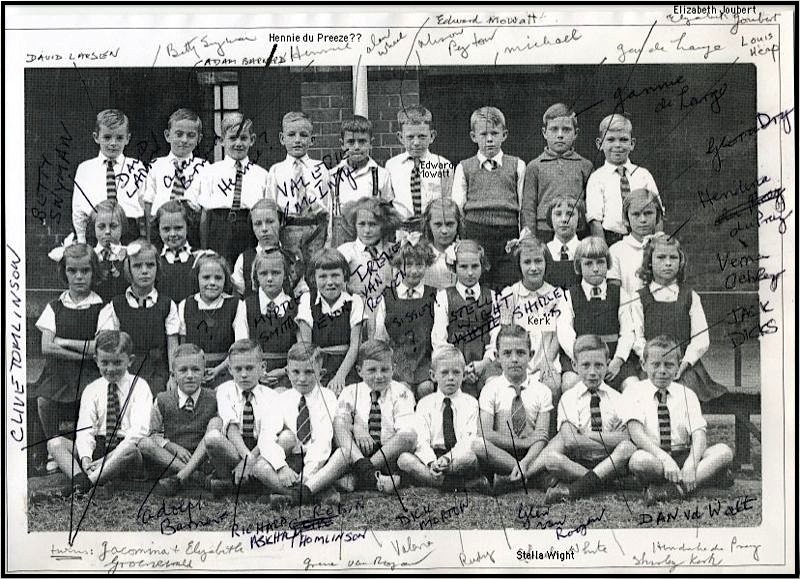 Names?
Names?
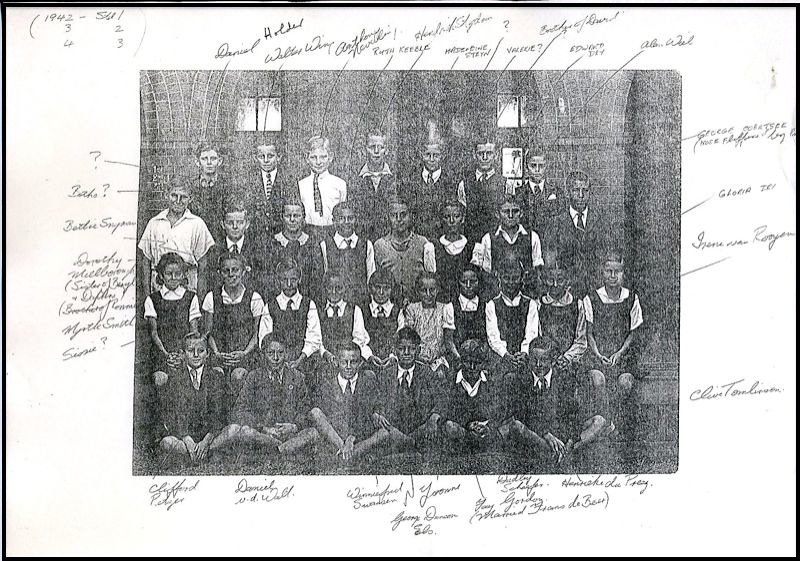 Names?
Names?
|










